COOPERATION MODEL
ARTIFICIAL INTELLIGENCE
PRODUCT ENGINEERING
DevOps & Cloud
LOW-CODE/NO-CODE DEVELOPMENT
FRONTEND DEVELOPMENT
CLOUD DEVELOPMENT
MOBILE APP DEVELOPMENT
LOW CODE/ NO CODE DEVELOPMENT
EMERGING TECHNOLOGIES







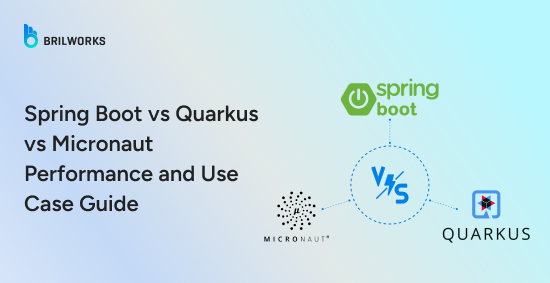
Comparing Spring Boot, Quarkus, and Micronaut is a favorite topic among developers evaluating Java frameworks. While they often solve similar problems, their approaches, performance, and developer experience vary significantly.
Spring Boot has long been the go-to framework. It works well out of the box and is familiar to most teams. Quarkus, on the other hand, emphasizes container-first thinking with faster startup times and reduced memory usage. Micronaut focuses on compile-time processing to keep runtime lean and avoid reflection.
Though all three support core Java concepts, the differences under the hood affect everything from performance to debugging in production. This guide walks you through these nuances with a focus on real-world usage, not just idealized scenarios.
If you're planning to build a high-performance Java application and unsure which framework to go with, our team can help. We’ve worked extensively with Spring Boot, Quarkus, and Micronaut in real-world projects, and can guide you toward the right architecture. If you're looking to scale your team or need expert support, hire Java developers from us who bring deep technical insight and practical experience.
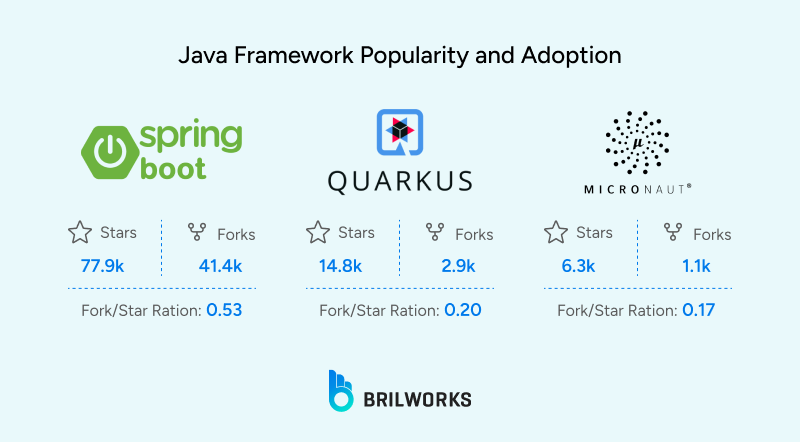
GitHub stats reveal the relative adoption of these frameworks. Spring Boot leads in both community size and activity, reflecting its long-standing presence in enterprise systems. Quarkus and Micronaut are growing steadily but remain smaller in reach.
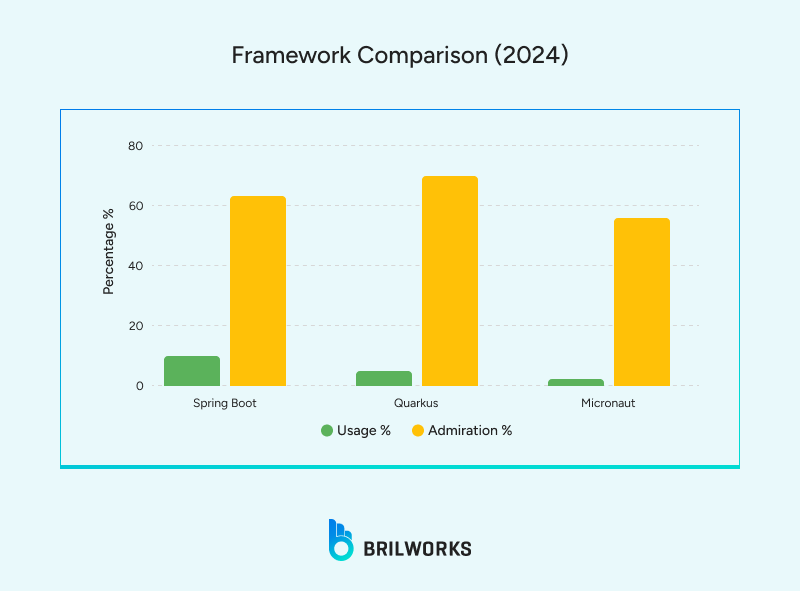
The Stack Overflow survey 2024 further illustrates usage. Spring Boot is widely adopted, while Quarkus scores high on developer admiration, highlighting a positive developer experience. Micronaut remains niche, particularly in embedded and resource-constrained environments.
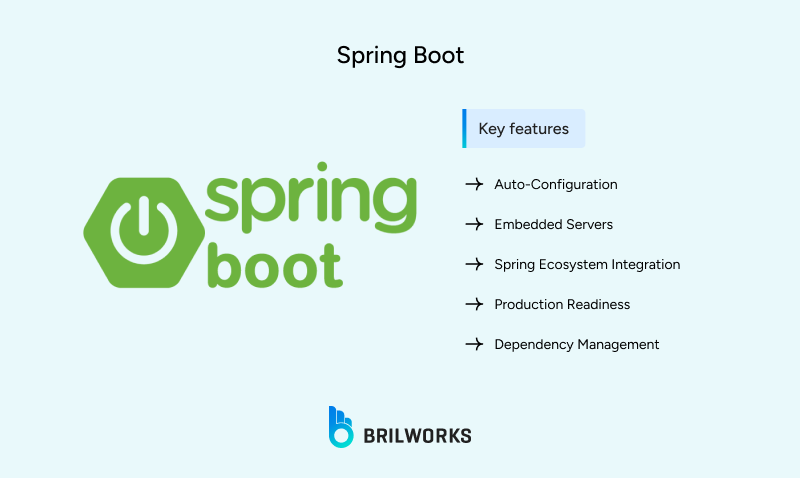
Spring Boot is built on the Spring platform and simplifies application setup by automating most configurations. It is especially popular in enterprise environments and backend systems. The Spring ecosystem includes tools for web development, security, data access, messaging, and cloud integration, all seamlessly compatible with Spring Boot.
Auto-configuration: Reduces manual setup by configuring dependencies automatically.
Embedded Servers: Supports Tomcat, Jetty, and other servers without separate WAR deployment.
Spring Ecosystem Integration: Works smoothly with Spring Security, Spring Data, and Spring Cloud.
Production Readiness: Includes actuator endpoints, metrics, and health checks.
Dependency Management: Starter packages handle transitive dependencies cleanly.
Ideal Use Cases
Enterprise Applications: Stable libraries and complex business logic.
Monolithic Services: Internal modularization rather than distributed systems.
API Backends: REST APIs for web and mobile apps; consider Node.js and Spring Boot trade-offs.
Legacy System Integration: Fits environments reliant on the broader Spring stack.
Pros
Mature, well-documented, and widely adopted.
Broad library support for databases, messaging, and cloud-native features.
Strong integration with enterprise security standards.
Cons
Slower startup and higher memory usage.
Auto-configuration may complicate debugging.
Can feel heavy for small services.
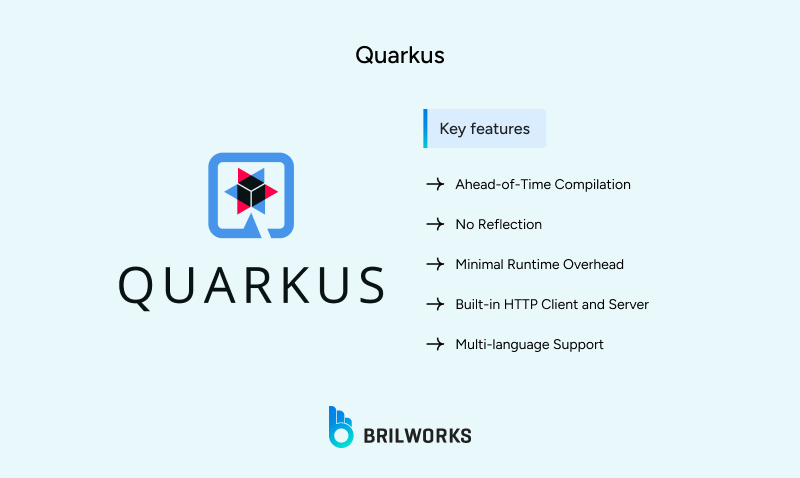
Quarkus is optimized for fast startup, low memory usage, and container-first development. Created by Red Hat, it works well in serverless and cloud-native environments. Quarkus supports both JVM and native builds via GraalVM.
Fast Startup & Low Memory: Ideal for Kubernetes and serverless environments.
GraalVM Native Image Support: Compiles Java apps into native executables.
Reactive & Imperative Programming: Flexible approach depending on project needs.
Live Coding: Hot reload lets developers see changes instantly.
Extension Ecosystem: REST, Kafka, security, OpenAPI, and database support.
Ideal Use Cases
Cloud-Native Applications: Optimized for containers.
Serverless Functions: Short-lived processes benefit from minimal cold-start latency.
Microservices at Scale: Efficient for running many small services.
Native Builds: Reduced runtime overhead.
Pros
Very fast startup and low memory footprint.
First-class native image support.
Developer-friendly live reload experience.
Cons
Smaller ecosystem than Spring Boot.
Native builds require extra setup.
Less mature integration for some libraries.
Not ideal for large monolithic or legacy migrations.
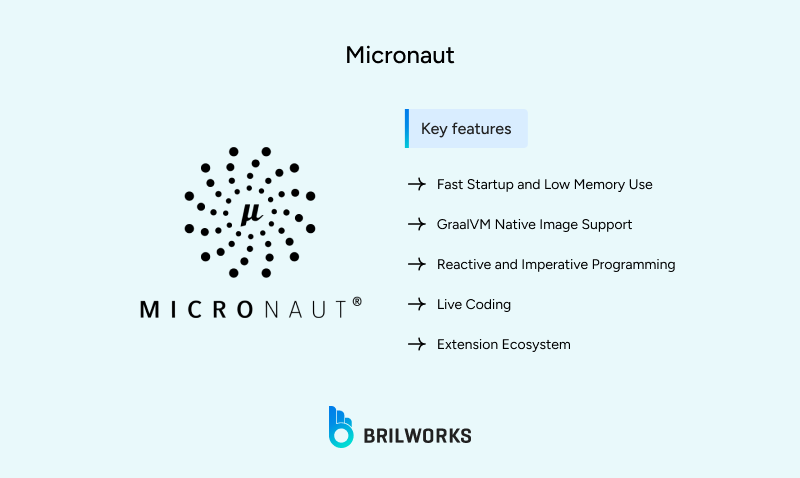
Micronaut is a lightweight Java framework that reduces runtime overhead by shifting work to compile-time. Developed by the creators of Grails, it avoids reflection and is optimized for fast startup and low memory usage. It supports Java, Kotlin, and Groovy, with growing cloud-native capabilities.
Ahead-of-Time Compilation: Reduces runtime costs.
No Reflection: Keeps memory low, essential for native builds.
Minimal Runtime Overhead: Loads only required components.
Built-in HTTP Client and Server: Eliminates the need for external libraries for basic networking.
Multi-language Support: Works with Java, Kotlin, and Groovy.
Ideal Use Cases
Microservices in Lightweight Environments: Small memory footprint and fast startup.
GraalVM Native Images: Efficient for native builds.
Reactive Systems: Event-driven or non-blocking applications.
IoT or Embedded Systems: Fits resource-constrained devices.
Pros
Fast startup and low memory consumption.
Predictable runtime behavior.
Strong native image support.
Built-in tools for common tasks.
Cons
Smaller ecosystem and limited third-party extensions.
Documentation improving but not yet comprehensive.
Learning curve for AOT concepts.
Community smaller than Spring or Quarkus.
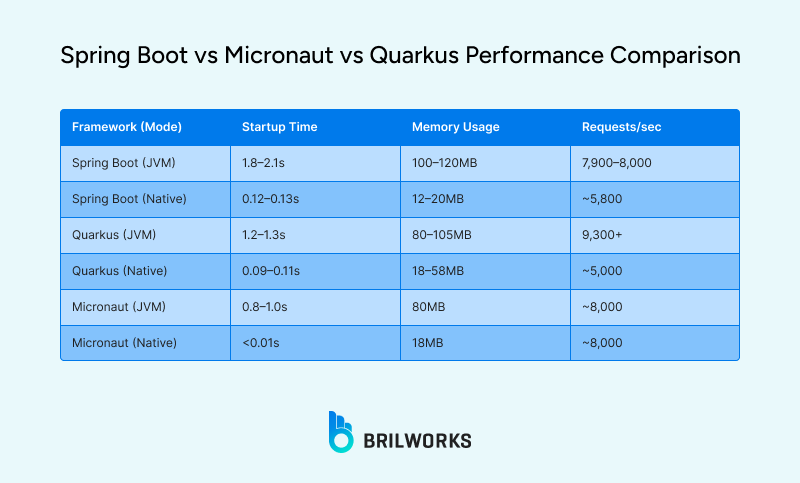
Performance is crucial for microservices or cloud-native projects. Startup time, memory footprint, and throughput vary between frameworks and deployment modes (JVM vs native).
|
Feature |
Spring Boot |
Quarkus |
Micronaut |
|
Startup Time (JVM) |
Moderate |
Faster than Spring |
Fastest |
|
Startup Time (Native) |
Fast |
Faster than Spring |
Fastest overall |
|
Memory Usage (JVM) |
High |
Moderate |
Low |
|
Native Image Support |
Spring AOT |
First-class GraalVM |
Built-in |
|
Developer Productivity |
High |
High |
Good (some learning curve) |
|
Documentation |
Extensive |
Well-organized |
Clean but limited |
|
Ecosystem & Libraries |
Broadest |
Solid |
Focused |
|
Community Support |
Very large |
Active |
Smaller but responsive |
|
Best Use Cases |
Enterprise apps, APIs |
Cloud-native apps |
Serverless, lightweight |
|
Learning Curve |
Gentle |
Medium |
Medium |
Key Notes:
Startup Time: Micronaut is fastest in native mode (<10ms), ideal for serverless workloads. Quarkus follows closely; Spring Boot is better suited for long-running services.
Memory Usage: Spring Boot consumes the most memory; Micronaut and Quarkus are more efficient, especially in native builds.
Throughput: Quarkus delivers top JVM throughput; Micronaut is competitive in both JVM and native modes. Native builds reduce memory and startup costs but may slightly impact throughput.
Mature tooling (Spring Initializr, IntelliJ/Eclipse support) and wide adoption make Spring Boot predictable. However, cold start times and runtime reflection can slow development cycles in large projects.
Developer-friendly with hot reload via Dev Mode, CLI tools, and fast builds. Some unlearning needed for Spring developers. Ecosystem is growing, but tutorials for edge cases may be limited.
Compile-time processing ensures fast builds and predictable runtime. CLI tools simplify boilerplate generation. Some IDE integrations may require workarounds. Ideal for modern, annotation-driven microservices.
Spring Boot: Deep integrations with databases, messaging, cloud providers, and Spring Cloud. Reliable for enterprise-grade systems
Quarkus: Solid extensions for REST, gRPC, Kafka, Hibernate, OpenTelemetry, and Kubernetes. Smooth GraalVM support
Micronaut: Focused integrations for HTTP, gRPC, Kafka, RabbitMQ, Redis, and cloud providers (AWS, GCP, Azure). Less breadth but lean builds and efficient runtime.
Spring Boot: Large monoliths, distributed systems, APIs, batch jobs, internal tooling. Strength lies in stability and enterprise integration
Quarkus: Cloud-native, container-first microservices, serverless, and scale-to-zero workloads
Micronaut: Lightweight microservices, serverless apps, mobile backends, IoT, and edge computing. Prioritizes minimal startup and memory usage.
Spring Boot, Quarkus, and Micronaut each have strengths shaped by their design philosophies. Spring Boot offers reach, stability, and a massive ecosystem. Quarkus focuses on performance, speed, and cloud-native readiness. Micronaut remains lean, fast, and ideal for memory-sensitive, serverless, or embedded services.
Your choice should depend on project requirements, deployment environment, and team expertise, not just benchmarks. For expert guidance on evaluating these frameworks or scaling your Java development projects, you can hire Java developers with real-world experience in Spring Boot, Quarkus, and Micronaut.
Micronaut generally starts fastest, especially in native mode, making it ideal for serverless and lightweight services.
Micronaut’s compile-time processing reduces runtime overhead, giving faster cold starts and lower memory usage compared to Spring Boot.
Use Quarkus for cloud-native microservices with container and GraalVM support. Choose Micronaut for lightweight, resource-constrained, or event-driven systems.
Migration is possible but not automatic. You’ll need to rework configuration, dependency injection, and integrations. It’s easier if your code is modular and loosely coupled.
Spring Boot has the largest and most mature community. Quarkus and Micronaut are growing quickly, but you may find fewer community examples or third-party libraries in some areas.
Get In Touch
Contact us for your software development requirements
Get In Touch
Contact us for your software development requirements